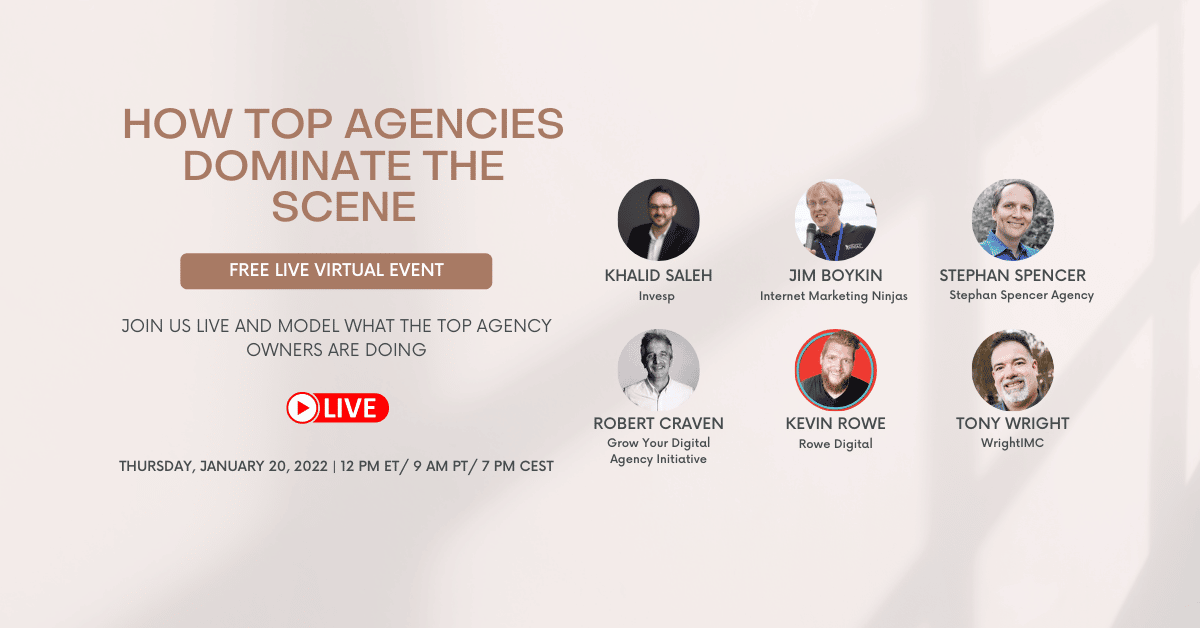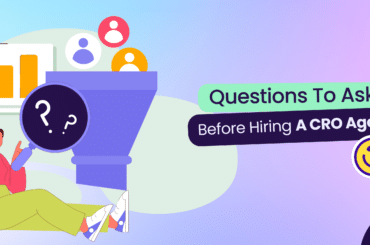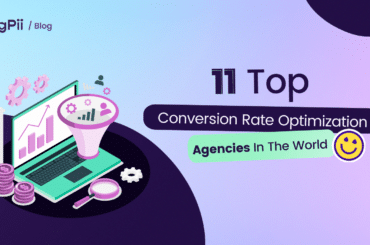When it comes to building your agency, things can be a bit unclear.
No one talks about what they’re doing, what’s working, and what’s not.
How to land better clients, what to do post-covid, and how to attract better talents.
The number of questions is just too much to comprehend in just one blog.
And so Khalid SalehFigPii’s CEO decided that he’ll change the status quo.
He talked to Robert Craven, the founder of the GYDA Initiative, Kevin Rowe, VP of product in PureLinq, who specializes in Webinars. Jim Boykin Internet Marketing Ninja’s founder who started doing SEO back in 1999 and now has a world-renowned agency, Stephan Spencerwho’s a big name in the SEO industry who’s worked with clients like Sony and Zappos and more. Lastly, Tony Wright who’s a sought-after speaker at industry events, including Search Engine Strategies, Pubcon, and others.
And in this webinar, they covered major four topics:
- How to Start a Successful Marketing Agency (A Complete Guide) – with Robert Craven
- Using Webinars to Generate Leads in 2022 with Kevin Rowe
- How To Scale Your SEO Agency From 1 To 40 Employees With Jim Boykin
- Digital Marketing Agency: How to price your service right with Stephan Spencer
- How To Chose Your Clients, Know What To Look For With Tony Wright
So let’s start one by one talking about some major headlines that each of our speakers dived into.
- How to Start a Successful Marketing Agency (A Complete Guide) – with Robert Craven
- Using Webinars to Generate Leads in 2022 with Kevin Rowe
- Digital Marketing Agency: When Do You Go For Pay For Performance with Stephan Spencer
- How To Scale Your SEO Agency From 1 To 45 Employees With Jim Boykin
- Digital Marketing Agency: How To Price Your Hourly Rate With Tony Wright
- How To Make Money Using FigPii With Khalid Saleh
How to Start a Successful Marketing Agency (A Complete Guide) – with Robert Craven
Before, During, and after Covid, the high-performing agencies perform differently from the rest.
What is it that they do differently, and what can we learn.
More importantly, if we know what they do, why can’t we emulate them? Or can we?
In this session, Robert explores in detail:
- Scary times, what’s holding you back
- Top questions agencies ask (and the answers)
- What the high performers do
- Is now a good time?
What High Performers Do Differently?
They’re very process-driven.
They focus a lot on the systems and processes.
They have a process that nearly all of them follow, plus or -5% and more importantly, the one key thing that makes them stand out is that they actually have hand-holders.
They have a coach, a consultant, or whatever you name it.
They don’t do it alone. It’s like that quote, it takes a village to grow a child.
Well, actually it grows a village to grow a business.
What’s Holding You Back?
FEAR!
It’s fear. It’s fear of charging the right price.
It’s fear of recruiting the right or the wrong person.
It’s fear of putting prices up.
It’s fear of do we have enough products or services?
It’s fear about knowing what’s going on next.
It’s not knowing what job you should be doing as the leader of the business. And that fear that holds you back.
High Performers Mindset
When you ask the high performers, what made them different?
They say, what separates us as high performance is that we recognize the problems.
It’s my mindset. It’s my issue. It’s a problem.
So the people who are trying to grow, think it’s all about the outside world.
The people who do grow, who really successful recognize that it’s about their mindset and their discipline.
So what’s holding you back? It’s you and your mindset.
Talent Drain
So the battle is all.
Not only have we got a great situation for everyone leaving their businesses, but we’ve also got wage inflation, a talent drain.
Everything is now global.
You’re competing for people all the way around the world, and more importantly, the people from anywhere can work for you.
And there’s global wage inflation. What we’re seeing in web design is that’s the place that things are really suffering.
With the rise of platforms, decreasing value recognized from the clients, wage inflation, increased competition, web design, and build are not the place you want to be.
For a lot of agencies. It’s really getting very commoditized.
Everyone’s struggling to understand now what a new normal is for where people work and how they work.
And it seems that most people, roughly 50%, have switched to working hybrid.
Using Webinars to Generate Leads in 2022 with Kevin Rowe
Kevin is the go-to person when it comes to SEO, Link building for enterprises, he uses webinars like this one to generate leads that pay 6-7 figures for his services.
In this session, Kevin shared some of the tactics he used to build his business and what should be doing to make a successful webinar?
Webinars are the best way to communicate
I’ll quote Kevin here when he was talking about what webinars are amazing?
Webinars are amazing for generating leads.
And I don’t think people are leveraging them in the right way.
When it comes down to, for me, webinars are a cornerstone for finding those big enterprise clients, they need to see you talk.
They need to know you’re an expert or that your team is an expert, that your solution is either the silver bullet that solves their problem or you, at the very least, solve their problem, whatever that might be.
I think, again, webinars, for me are the best way to communicate that. And not just this.
I think webinars also have a tendency for me to be something that’s an easy way to get to the right audience as well.
What’s the right tactic to do killer webinars?
The tactic I’m using to do all this is really just finding the audience where they are.
I’m understanding the issues they’re having, and I’m actually coming up and discussing solutions to problems that are big for them.
It really comes down to it like I actually go into their issues. What are the issues how do they relate to my product and what is that connection?
That doesn’t necessarily mean you’re going to sell the product. I’m talking about some of the topical ideas. So I’ll give you an example for Pure Link. So with Pure Link right now, we have pretty aggressive growth.
One of the things we’re doing is a lot of Webinars, and my relationships are also driving a big part of that growth.
So we’ve had over 3000% growth of PureLinq. PureLinq is now poised we’re taking it to 20 million next few years.
So it’s not a massive company, but it’s a good growth trajectory.
How To Leverage Your Customers Problems?
And so the path we’re taking leveraging webinars for that.
It really comes down to just finding the people, the audience that has these problems, a common problem, that we’re solving it.
It comes down to how you actually went about solving that problem, how you identify the problem, and how you talk about that problem.
It doesn’t necessarily mean you’re selling a product to solve that problem at the time, but everyone’s out there trying to find solutions to the problems they’re having on a day-to-day basis anyway.
Why don’t you just talk about those problems now?
Selecting it is a hard part and the messaging is a little harder. But finding people that are looking to solve problems, that have the money to solve those problems, that you are solving those problems better than anybody else, or at least you’ve figured out how to solve those problems and they trust that you can solve that problem.
Selling the product comes as a natural consequence of that.
Digital Marketing Agency: When Do You Go For Pay For Performance with Stephan Spencer
Stephan Spencer has been in the SEO industry for a decade and a half, he’s worked with fortune 500 companies over the years so he’s locked down his pricing strategy.
How do you figure out the right pricing?
Stephan talks about how he did a performance-based pricing model which helped him generate a 7 figure
“Yeah, well, if I can do pay for performance, I am interested in that.
I have a number of deals where I’ve become an equity business partner with some of the clients that I’ve worked with over the years. Now, it’s not selective. I’m not saying yes to everybody.
It’s probably one out of 50, but that’s fun for some.
I’ll get dividend checks.
It’s amazing to be on the ride with them.
So, Gravity Stream is a service that I invented back in 2003 and wrote the first prototype, and it just ended up being a cost-per-click-based SEO solution.
It’s a middleware layer between the clients’ website and the greater internet and of course, Googlebot.
So we were able to do all sorts of really clever optimizations that were not easily done with the CMS or e-commerce platform that the client was on.
And by charging $0.10 a click, it was performance-based. And they were able to put it side by side with their pay per click costs on the AdWords side.
And yeah, we’re just going to buy as much of the traffic as we can from Gravity Stream.
And yeah, we had clients like Nordstrom and Zappos.
We were getting with Zappos seven figures.
And revenue from them in one year is amazing.
Now trying to charge that kind of price for services that are just consulting, audits and meetings and reporting and all that sort of stuff.
No way, not at that time. Maybe you can do that now. I don’t see very many companies that charge seven figures a year for consulting anyways, so that was a really great innovation.
I ended up selling that technology in 2010 to CAVARIO.
That then got bought by Densu Ajis and that was the majority of our revenue.
We were an agency, we were a SAAS company masquerading as an agency.
How To Scale Your SEO Agency From 1 To 45 Employees With Jim Boykin
Jim’s Internet Marketing Ninjas is one of the most sought-after SEO companies in North America and Europe.
He has a long waitlist just to work with his agency.
Now the question you’re thinking about is “Why doesn’t he just hire more people?”
Well, here’s a direct quote from him that’ll answer your question.
Why Going From 40 To 100 Employees Was A Bad Idea?
“Well, it hasn’t always been the start of the business to where we are now, hasn’t always been like a straight line.
There’s been ups and downs all along the route. And I guess all of those downs, I guess you learn lessons as well.
And how do you not have another down again?
It started out as just me back in 1999. I think in 2002 is when I started to hire and more work than I can handle.
And it was a big jump from going, I’m trying to feed myself and now I have to make enough to feed other people as well.
I didn’t hire for a couple of years when I perhaps could have just for that fear of going to that next level.
And when I got to that next level, I remember different times when things changed along the way and realizing different things because you’re a different company with four people, eight people, 15 people, 30, 5100. I think at one point back in.
So we kind of slowly grew, so to speak, over the years. I remember it was back in 2011. Maybe is when I made a mistake.
Hindsight is 2020, but I made the mistake of going, hey, we’re 50 people now. I want to go to 100 and somehow I set my goals to be a 100 person company and focused on that goal for a couple of years and reach that 100.
And then at one point had to do a correction, which was never a fun thing to do. And after that correction, I call it a correction.
It really stunk.
I think that was what in 2013, maybe early 14 that realized I can’t handle this.
I guess there are lots of reasons.
But when I, the person who is always on the front line, now have 100 people, I don’t know everyone’s name.
I’m not involved as much with the clients or with the employees.
And there’s a big pyramid of levels to go through. And the service at that point definitely took a dip. And so once we kind of corrected and got to that size of roughly about 45, I realized that’s the number I like, I can manage that many people. I can be on the front line.
We can do a diagram that’s more a circle. It would be in the middle and not some hierarchy thing. And if I need the old days, if I needed something, I would tell the assistant, my assistant would then tell the director of whatever, the director of whatever would tell the team leader, the team leader would tell the team, oh my gosh, things did not work.
And I found that 40 to 45 for me and my company was kind of the perfect size. So at one point, I’m like, we’re just going to keep this size. And so that was around 2014 that we got back down to that 45 side.
And I’ve different than most companies where I think the fear was for years, if you’re not growing, you’re dying.
And so it’s like always has to grow, always has to grow, always has to grow.
And something I think that’s different with me than maybe with other people is I’m happy to maintain the level of where we’re at, I’m really happy.
The nice thing is we’re a private company. I own 100% of the company. I don’t have to answer to shareholders or anything. There’s not that need to make money.
And I’m like, if I make X amount of money, I’m a happy guy.
And if I’m happy, that’s fine. And I found my happy sweet spot.
And so, yeah, probably since 2014, there’s probably been a waiting list for our service, maybe 70% of the time.
And we’ve had, I guess I can list names, but we’ve had a lot of clients wait for a long time and then they give up.
And it’s like, sorry, I am not going to take on more work than what we can do.
I know that this is a size where we can give the perfect amount of work and go bigger and hire a bunch of new people.
The average Ninja has been with me for more than nine and a half years, nine and a half, which is a long time.
Digital Marketing Agency: How To Price Your Hourly Rate With Tony Wright
When we asked what pricing model he was using for his agency his answer was a little bit unexpected, an hourly rate but with a twist!
Here’s a quote from him explaining what I mean by that.
“Our philosophies on pricing are quite a bit different at the end of the day, truly as an SEO always sells time.
Now if you’re doing PPC, you’re also selling advertising. Maybe, but usually, that’s just a pass-through.
But at the end of the day, I’m really just selling my time and my employees’ time.
And whether I couch that as a project or whatever.
And Stephan made a good point when you’re pricing whatever model you’re using, you have to look at it from a time-based perspective because we see it all the time.
Someone does a project and then all of a sudden they spent 200 hours on this project that they charged $1,500 for.
We can get into all the reasons for that and what happens. So about three years ago, I made the decision. My background is in public relations.
That’s where I came from big PR agencies and also I have relatives that are lawyers and kind of went more back towards that model, which is essentially we charge on an hourly basis.
But the way we couch it, it acts as a retainer in most cases because we create a minimum number of hours that a client will commit to each month.
Now, what happens there is, and then we go in and plan what’s going to happen each month, the month before it happens, as opposed to creating a set of deliverables.
There’s a very popular SEO blueprint that’s going around.
A lot of people seem to be using it, I guess, in the agency consulting world.
And frankly, I don’t like that.
They set up the packages and it’s basically they’re creating you get four blog posts, three pages optimize, et cetera, each month.
And I can’t do that when we have done that in the past.
By the time three months roll around on that contract, what we’re doing looks absolutely nothing like the contract.
And then if you ever get into a dispute about what was done, everybody goes back to the contract and immediately highlights, this was never done.
You were supposed to give us four blog posts a month. Well, yeah, we were supposed to, but we ended up redesigning half of your site. It’s kind of a give and take.
So we moved to completely to hours now. And there are so many benefits to doing it this way.”



